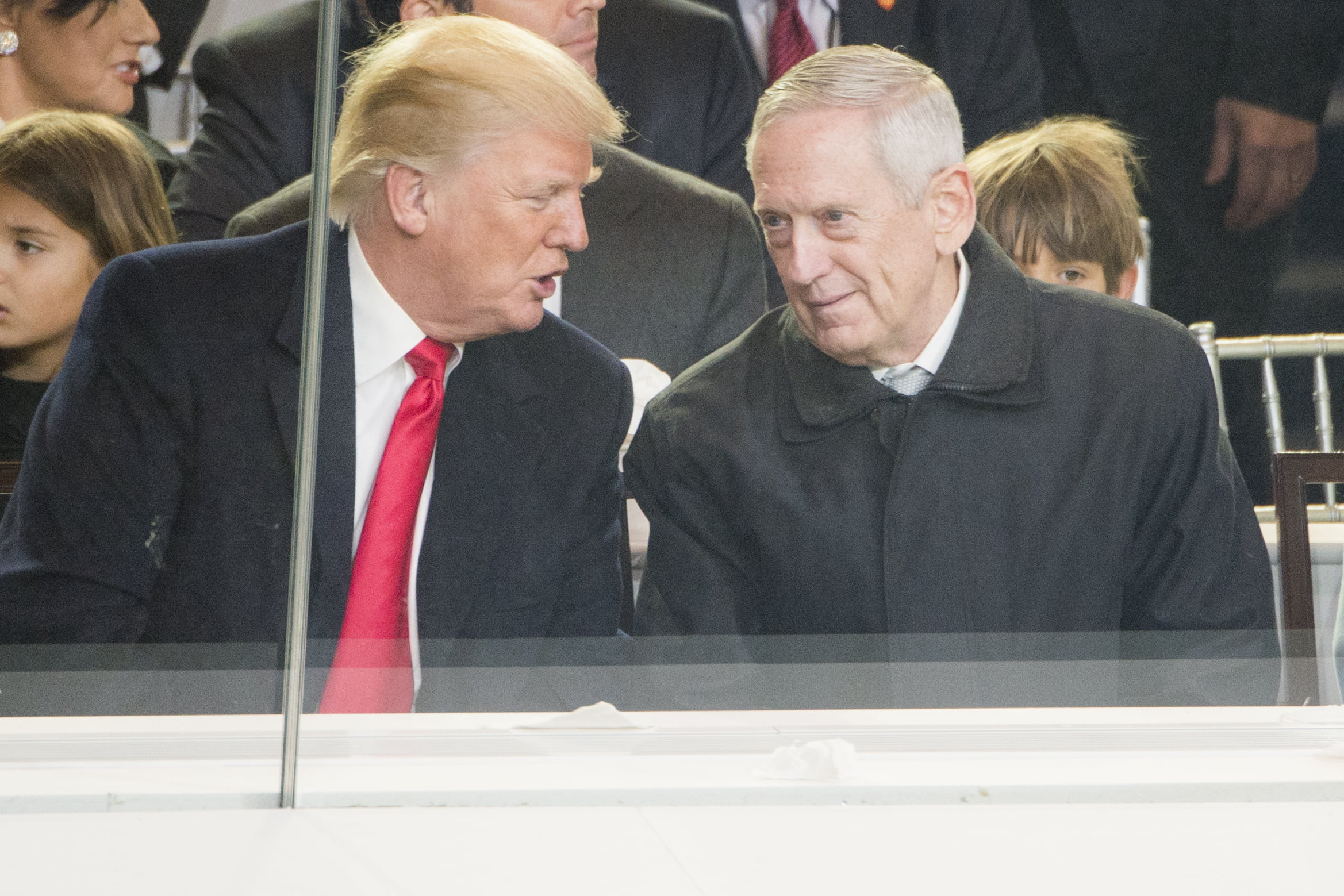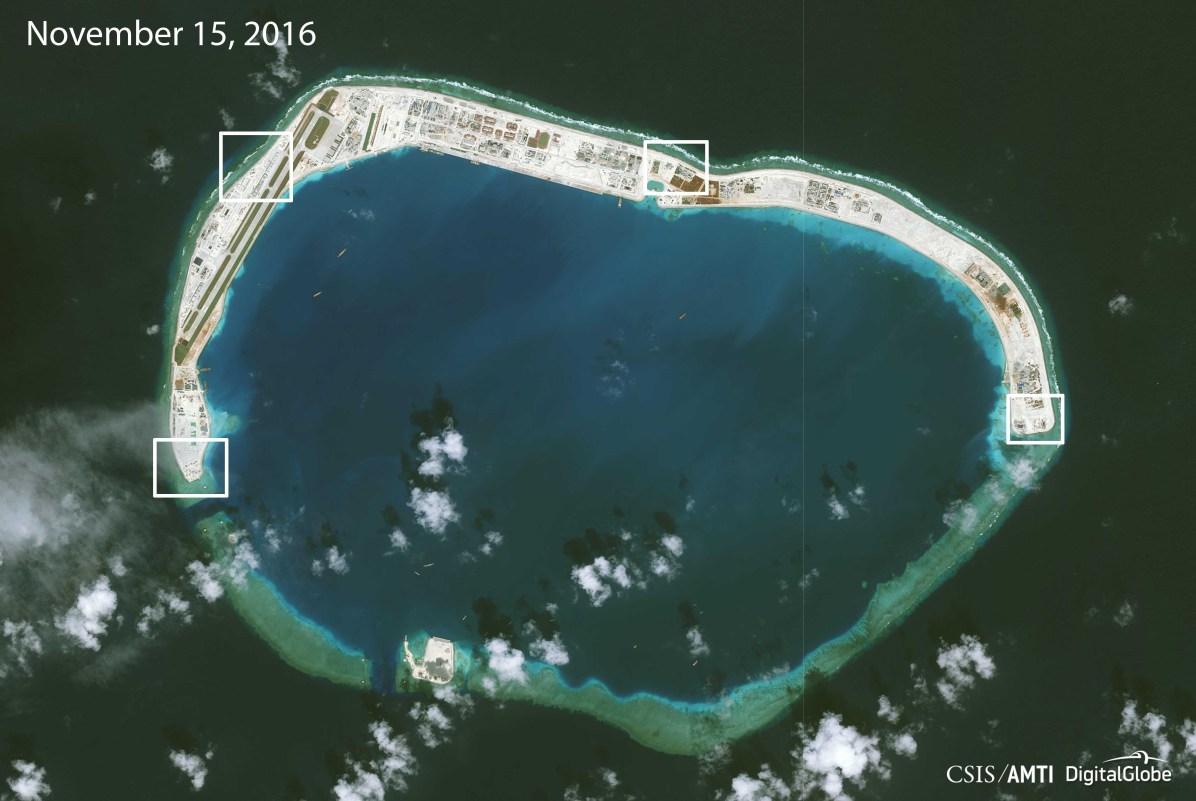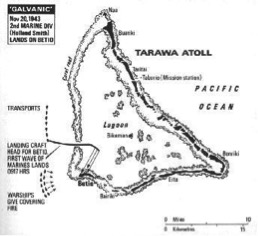2017-01-22 In an unprecedented situation, three senior positions are held by senior Marine Corps officers, one current and two former.
 President Donald J. Trump and newly appointed Secretary of Defense James Mattis watch as parade participants march past the White House reviewing stand during the 58th Presidential Inauguration Parade in Washington D.C., Jan. 20, 2017.
President Donald J. Trump and newly appointed Secretary of Defense James Mattis watch as parade participants march past the White House reviewing stand during the 58th Presidential Inauguration Parade in Washington D.C., Jan. 20, 2017.
The current one, of course, is General Joseph Dunford, Chairman of the Joint Chiefs of Staff.
The former ones are Generals Mattis, Secretary of Defense, and Kelly, Secretary of Homeland Security.
Given the significant operational experience of both the new Sec Def and Sec DHS and their work with allies, it is difficult to believe that they will not have a key role in shaping the new President’s approach to how the US deals with allies on both defense and security issues.
In the video below, the Chairman greets the new Sec Def on his first day on the job, January 21, 2016.
Meanwhile Back at the Pentagon: OO-RAH from SldInfo.com on Vimeo.
The Marine Corps perspective is especially welcome at this point in time given the threats and challenges.
First, the Chinese Wall of Sand reminds the Marines and the Navy of their past at Tarawa Atoll.
As Ed Timperlake recently noted:
When reading a recent article on the Chinese illegal build out on islands in the Pacific, I was struck with what the images reminded me of from history.
In an article on “China’s New Spratly Island Defenses,” published by the Asia Maritime Transparency Initiative, several digital globe photos were provided highlighting the build out and its physical characteristics.
One of these photos was of Mischief Reef.
This photo is a dead ringer for the Japanese and the Tarawa Atoll.
The Battle of Tarawa was the first American offensive in the critical central Pacific region.
It was also the first time in the war that the United States faced serious Japanese opposition to an amphibious landing.[5]
Previous landings had met little or no initial resistance,[6][N 1] but this time the 4,500 Japanese defenders were well-supplied and well-prepared, and they fought almost to the last man, exacting a heavy toll on the United States Marine Corps.
The U.S. had suffered similar casualties in other campaigns, for example over the six months of the Guadalcanal Campaign, but in this case the losses were incurred within the space of 76 hours.
https://en.wikipedia.org/wiki/Battle_of_Tarawa
More than 1,000 U.S. troops were killed in action and some 2,000 were wounded in only three days of fighting at Tarawa.
Word of the heavy casualties soon reached the U.S. and the public was stunned by the number of American lives lost in taking the tiny island.
However, according to “The Pacific War” by John Costello, U.S. commanders learned important lessons from the Battle of Tarawa that would be applied to future atoll wars, including the need for better reconnaissance, more precise and sustained pre-landing bombardment, additional amphibious landing vehicles and improved equipment: Among other advancements, better-waterproofed radios would be developed.
http://www.history.com/topics/world-war-ii/battle-of-tarawa
History in the rear view mirror can be applied to the future as well.
It is important to take the PRC offensive seriously.
Second, with the ramp up of the fight against ISIS, the battle hardened experience of Mattis as a Fallujah Marine provides a baseline towards success.
Third, the arrival of the Green Knights into Japan provides new operational capabilities which the United States and its allies can build upon going forward.
The second and third points were highlighted in the person of U.S. Marine Corps Lt. Gen. Lawrence D. Nicholson, commanding general of III Marine Expeditionary Force (MEF), the man who led the welcoming ceremony for the arrival of the Green Knights, ironically on the same day that the 45th President of the United States was sworn in.
At the 10th Anniversary of Fallujah, Lt. General Nicholson was the guest of honor.
The Commandant of the Marine Corps, Gen. Robert B. Neller, is calling 2016 “the year of reunions.” A video message for 25th Marine Regiment from Neller was played during the event. He thanked the service members for all they did in Fallujah and reminded them to continue to look out for one another.
“I am proud to say that I saw what you did out there, saw the sacrifices you made and I know how well you served, so thank you for that,” said Neller. “I know you are taking care of each other, staying in contact and helping each other get on with their lives.”
The guest of honor at the reunion was Lt. Gen. Lawrence D. Nicholson, commanding general of III Marine Expeditionary Force. Nicholson was the commander of 5th Marine Regiment, 1st Marine Division, in 2006, and deployed with 25th Marine Regiment to Fallujah. He spoke to the service members about how proud he was of their actions and how the difference they made will never be forgotten.
“There is a connection here that will be unbroken for the rest of your lives,” said Nicholson. “You are Fallujah Marines until the day you die. They will talk about you long after you are gone. The way we talk about Guadalcanal Marines and Iwo Jima Marines today, is how they will talk about you.”
http://www.marines.mil/News/News-Display/Article/973681/fallujah-marines-reunite-after-10-years/
If I were a leader of ISIS, I would more than start to worry.




